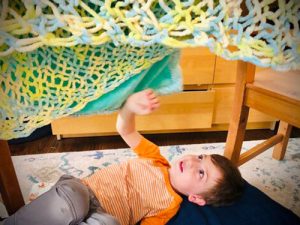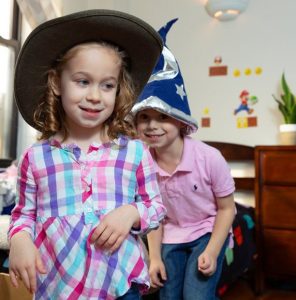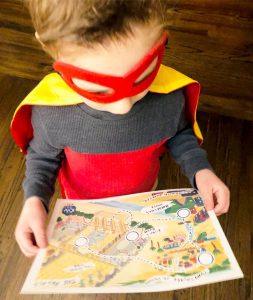
Apr 06 2022 Act It Out: 6 Simple Ideas for Using Dramatic Play with Stories
How can you bring playful drama and theater activities into your relationship with your grandchild ages 5–10? Theater activities can be a fun — and sometimes silly — way to engage with your grandchild while stimulating their development, whether you are together in person or at a distance.

Young children naturally explore imaginative play, taking on different roles and bringing stories to life. Dramatic play can help children foster creative thinking, develop empathy, build social skills, and generate impactful memory retention. By encouraging this type of play and joining in the fun, grandparents can deepen the bond with their grandchild while creating lasting memories.
This idea is also rooted in our Jewish tradition. For example, we read in the haggadah that we are to retell the Passover story “as if we ourselves” were there experiencing it. This imagination-driven approach can be applied across the canon of Jewish holiday stories, activating each ritual and celebration through play.
![]() Click HERE for the video recording “Grandparents, Bring Your Family Seder to Life.”
Click HERE for the video recording “Grandparents, Bring Your Family Seder to Life.”
Here are 6 simple ideas for dramatic play with stories:
Pick a Story to Stage
With your grandchild, decide on a story to bring to life. The story can be drawn from a picture book that your grandchild loves (here are some great ideas), or a story from Jewish tradition that you’d like to share (Purim and Passover offer lots of dramatic play possibilities).
For children ages 3–6, start small by enacting only one part of the story and build on that based on the interest they show. For ages 8–10, review the story together, either by rereading the book together, or retelling the story with your grandchild. Boil the story down to a beginning, middle, and ending scene. Ask your grandchild to recount it: “What happens at the beginning? Then what happens? How does the story end?”

Set the Stage
Find an open space to play together. Collect objects from around the house to create your setting, like bed sheets, chairs, and pillows. Ask your grandchild to be the designer and you can be the helper.
If you are at a distance, use the video chat screen as your stage. Gather objects in your own spaces to use, and think about the ways your video window can become a stage. With video, you can play with scale by getting closer or further away from the screen. You can also have objects appear on the camera while your face is hidden off camera.
Choose Your Characters
Decide which character you will each play; for example, you might play Pharaoh and your grandchild can play Moses. Start with, “Let’s pretend we are _____.” Move like your character. Talk like your character. Ask your grandchild what you can do to be more like the character you choose. Let them direct you!
On a video call, you can play with creative ways for your characters to interact. For example, if you each have the same object, you can pretend to pass it to each other “through” the screen. Moses can hold a cup and pass it out of frame at the same time that Pharaoh moves a cup into the video frame!
Plan Your Costumes
Use items from your closet to create costumes together. Be silly and creative by using hats, ties, scarves, and other items. Become costume designers for each other by picking items for the other person to wear.
At a distance, you can each bring a pile of clothing back to the screen, and surprise each other by jumping into the frame wearing different costumes.
Pick Some Music
Together choose background music to support your production. Ask your grandchild to choose their favorite song. It doesn’t matter if it’s inappropriate for the story! You can also find sound effects online to help set the scene. Or create your own sound effects with pot lids, wooden spoons, a xylophone, rustling paper, or any other objects your grandchild chooses.
Start the Action
Now that you have your characters, costumes, and settings, it is time to bring the story to life. Together, say “1, 2, 3, Action!” and get ready to act it out. You can decide on a few lines each person will say in advance, or just make it up together as you play. Let your grandchild direct the creative play and take their lead. Once you finish the scene, say “cut” or “The End.” Ask your grandchild if they want to do it again. You can also try switching roles!
How can you make imaginative play a regular part of your time together in person or on video calls? Being silly together and going on creative adventures will make a lasting impression on you and your grandchild, while offering them essential skills that will serve them as they grow.
You can also use dramatic activities to bring holidays and Jewish stories to life throughout the year. For more ideas, explore Play-Along Parsha as a weekly resource to bring Torah to life through simple dramatic play.
Jonathan Shmidt Chapman is the founder of The K’ilu Company, creating projects that activate Jewish early childhood education through theater and imaginative play. He is the creator of K’ilu Kits — interactive audio adventures that bring Jewish holiday stories to life — and Play-Along Parsha — a resource for 3-to-6-year-olds and their families to creatively engage with the weekly Torah portion. Jonathan was previously the Producer of Family Programming at Lincoln Center for the Performing Arts in New York.
Photographic Credits
Photographs with child in pink shirt by Hyphen Photography
Other photographs by Jonathan Shmidt Chapman






 We use technologies like cookies to remember your preferences. Consenting to these technologies will provide you with a better browsing experience. JGN never shares information about your use of our website.
We use technologies like cookies to remember your preferences. Consenting to these technologies will provide you with a better browsing experience. JGN never shares information about your use of our website.